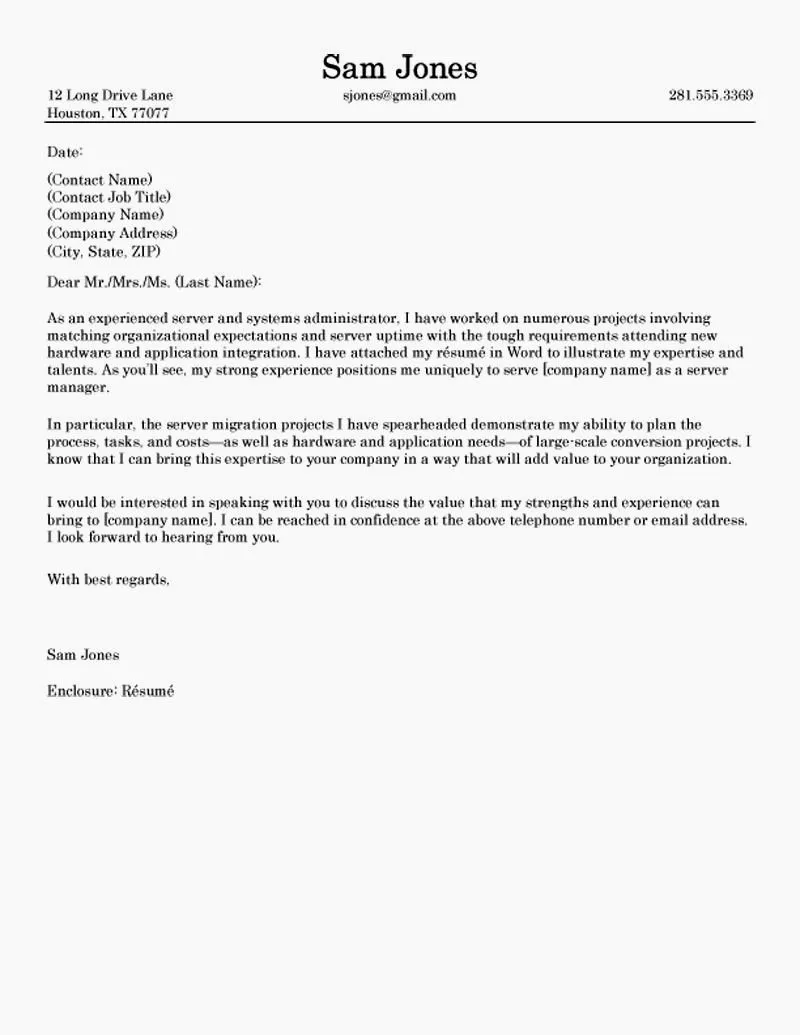Understanding Salary Requirements in Cover Letters
Navigating the job application process can be challenging, and one of the trickiest aspects is often addressing salary expectations in your cover letter. Knowing how to approach this topic can significantly impact your chances of landing an interview and ultimately, a job offer. This guide will explore the nuances of including salary expectations in your cover letter, providing you with the knowledge and tools to confidently navigate this critical step. We will delve into the ‘why,’ ‘how,’ and ‘where’ of mentioning salary requirements, helping you make a positive impression on potential employers.
Why Mention Salary Expectations?
Many job seekers question whether or not they should even mention salary requirements in their cover letter. While some may advise against it, understanding the advantages of including this information can change your perspective. It’s all about striking the right balance between transparency and providing the information the employer is looking for. Mentioning your salary expectations at the right time can show that you understand the job and know your worth. However, being overly assertive can sometimes be counterproductive.
Benefits of Including Salary
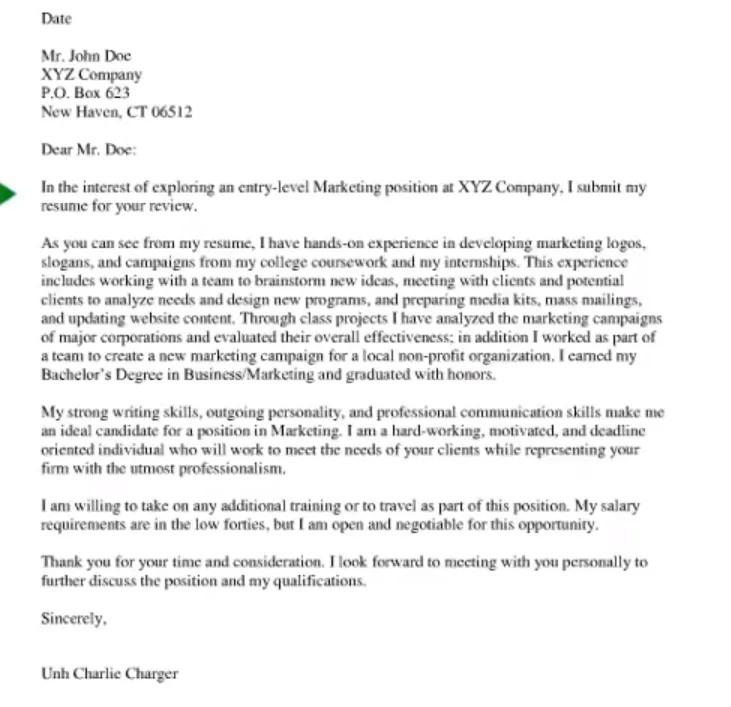
Including your salary expectations can streamline the hiring process. It helps both you and the employer determine if your salary expectations align with the job’s budget. If you’re within the range, you’re more likely to proceed to the next stage of the interview process, and if not, both parties can save time by not moving forward. This upfront approach shows that you are proactive, realistic, and serious about the position. It’s a sign of professionalism and respects the employer’s time by being transparent from the get-go.
Risks of Ignoring Salary
Choosing not to mention your salary expectations can sometimes lead to wasted time for both parties. You might progress through the interview process only to discover that the offered salary is far below your expectations. This is a frustrating scenario for everyone involved. If the job application specifically asks for your salary expectations and you ignore the request, it could be seen as a sign that you’re not following instructions or are avoiding the question. While it’s not always necessary, consider the specific requirements of the job and the company culture when making this decision.
Best Practices for Stating Salary
When you decide to include salary expectations, it’s essential to do so strategically. This means doing your homework, knowing your value, and conveying your expectations professionally. Whether you are applying for a job through an online portal or sending a cover letter directly to a hiring manager, these are some aspects that you will have to consider. Make sure that you are well-prepared and have a good understanding of the situation before you begin.
Researching Salary Ranges
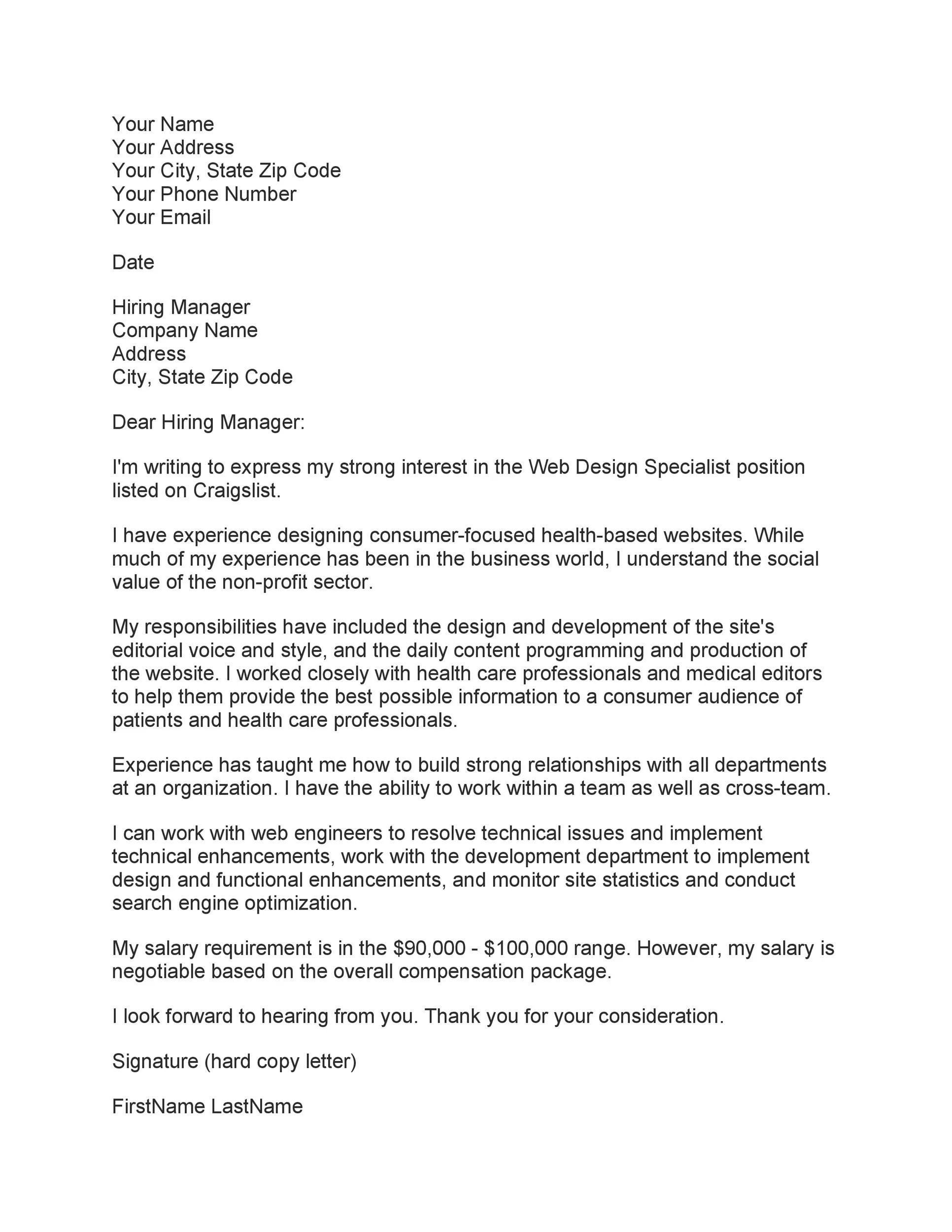
Before you even start writing, research the typical salary range for the position and your experience level. Several online resources provide salary data based on job titles, locations, and experience, such as Glassdoor, Salary.com, and LinkedIn Salary. These resources can give you a realistic idea of what the job is worth. Consider your skills, education, and the cost of living in the area when determining your target salary. Also, research the company and its compensation practices. Some companies are known for higher salaries than others, and understanding their history can help you make a more informed decision.
Using Salary Ranges
Instead of stating a specific salary, it is often better to provide a salary range. This allows for some flexibility and shows that you are open to negotiation. A range demonstrates that you’ve done your research, understand the market, and are realistic about your expectations. When you provide a range, make sure it is appropriate for the position and aligns with industry standards. Make sure that your range is not too wide, or it may appear that you have not carefully considered your expectations. A good rule of thumb is to keep the range within $10,000 - $15,000. (See image of example of salary range)
Stating Your Current Salary
While not always necessary, some companies may ask for your current salary. If you are comfortable sharing this information, you can do so. In your cover letter, you can briefly state your current salary or salary range. Be prepared to explain how this salary aligns with your experience and the new position you’re applying for. If you feel that your current salary is below market value, you can frame your response by highlighting your skills, qualifications, and the value you bring to the new role, rather than focusing solely on your current compensation. Be sure to include your expected salary range or salary.
Where to Place Salary Requirements in a Cover Letter
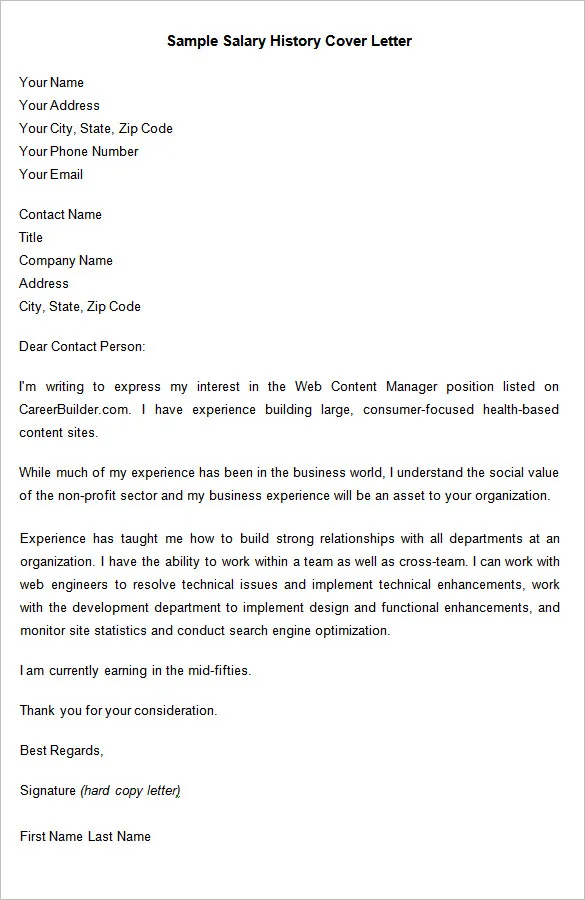
The placement of your salary expectations in your cover letter is also very important. It should appear in a place where it feels natural, and where the hiring manager will easily find it. Some placement options are better than others. The objective is to maintain a professional tone and seamlessly integrate this information. Avoid placing the salary information too early in the cover letter, as it may seem presumptuous or off-putting. Here are some suggested spots and examples.
Opening Paragraph
Generally, it is not advisable to include your salary requirements in the very first paragraph of your cover letter. This section should be used to express your interest in the position and briefly highlight your most relevant qualifications. However, if the job description explicitly requests salary expectations in the opening, follow the instructions to show that you have paid attention to detail.
Body Paragraph
The body paragraph is often the best place to include your salary expectations. After you’ve outlined your skills and qualifications, it’s natural to discuss your career goals and compensation requirements. This is where you can transition to expressing your salary expectations in a professional and confident manner. This part allows you to link your value to the company with your salary request. You can directly address it in a separate sentence or include it within a paragraph that discusses your fit for the role.
Closing Paragraph
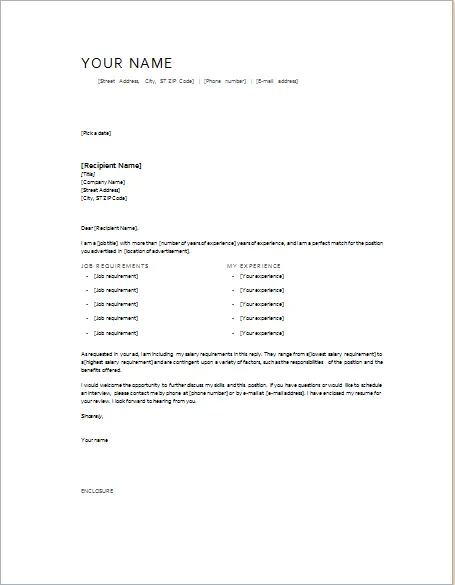
The closing paragraph is an alternative location, especially if the body of your letter primarily focuses on other qualifications. It’s a good spot to reiterate your interest and mention your salary expectations briefly. If you choose this route, ensure your closing is not solely focused on salary, but maintains a tone of enthusiasm about the position and the opportunity to discuss your qualifications further during an interview. This will demonstrate that you are interested in the job first and salary second.
Example Salary Requirement Statements
When stating your salary requirements, be clear, concise, and professional. How you phrase this part will influence the hiring manager’s opinion of you. Here are some examples of how to include salary requirements, ranging from specific numbers to open negotiation. Note the context, and choose the example that best suits your situation and comfort level.
Option 1 Specific Salary
While less common, you might state a specific salary if you are certain of your value and the job description clearly states the budget for the position. “Based on my experience and the responsibilities outlined, I am seeking a salary of $X per year.” This option provides clarity and confidence. Be sure to have a strong justification for this specific number, as it might lead to an immediate rejection if the company can’t meet it. If you’re not sure, using a range is safer.
Option 2 Salary Range

Using a salary range is often the best approach, as it shows flexibility and understanding of market values. “I am seeking a salary in the range of $X to $Y, commensurate with my experience and the responsibilities of the role.” It is a strong and confident statement. This shows that you are open to discussion and negotiation. Providing a small salary range shows that you are serious about the offer and can be a great starting point for negotiations. (See image of salary range example).
Option 3 Open to Negotiation
If you prefer to postpone the discussion of salary until the interview stage, you can phrase it this way: “I am open to discussing salary expectations during the interview, based on the scope of the role and the company’s compensation structure.” This option gives you more time to assess the company and the specifics of the job before committing to a number. Be prepared to discuss salary in detail during the interview if you use this option. If the job post asks you to specify your salary range, do not use this option. This will show that you do not follow instructions.
Mistakes to Avoid
There are several common mistakes to avoid when including salary requirements in your cover letter. Being aware of these pitfalls can help you make a positive impression and increase your chances of moving forward in the hiring process. Knowing what not to do is just as important as understanding what to do. Avoiding these mistakes is essential to showcasing your professionalism and securing the best possible outcome during the negotiation phase.
Being Too Vague
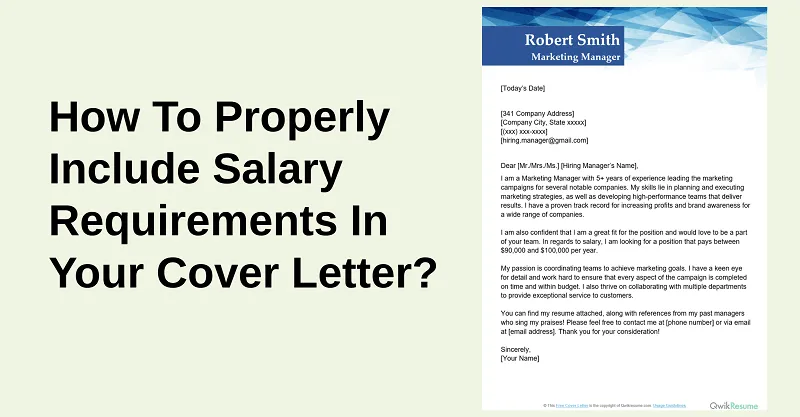
Avoid being too vague or using phrases like “competitive salary” or “negotiable.” These statements offer no concrete information and do not showcase your knowledge or research. They also force the employer to guess your expectations, which is not ideal. Provide a clear salary range or state that you are open to discussing your expectations during the interview stage, if that is the best fit.
Demanding an Excessive Salary
Demanding an excessive salary is another mistake. Research the industry average and your experience level before setting your expectations. Requesting a salary far above the normal range, especially in the initial stages, may immediately disqualify you. Aim to align your salary expectations with the market value and your skillset. Be realistic about your value and the needs of the employer.
Not Tailoring to the Job
Always tailor your cover letter and salary expectations to the specific job. Generic statements or the use of a template without any adjustments is a mistake. Ensure your expectations align with the job description and the responsibilities outlined. If the job description gives a salary range, refer to that. This will show that you have reviewed the job details and are serious about the position. A tailored approach demonstrates your attention to detail and genuine interest in the role.
Final Thoughts and Next Steps
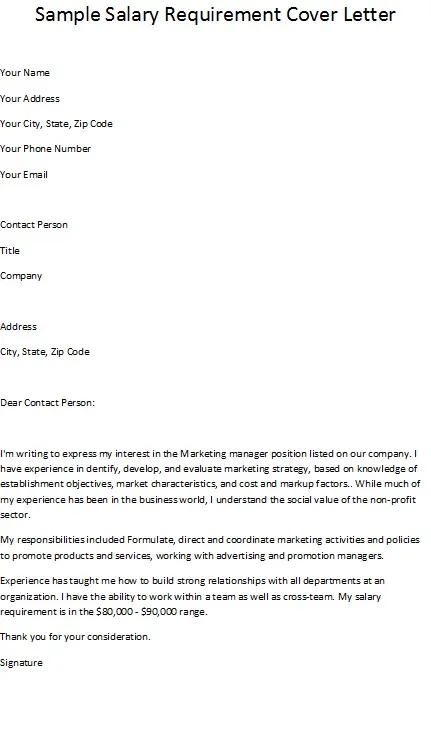
Including salary expectations in your cover letter can be a strategic move if done correctly. By understanding the ‘why,’ ‘how,’ and ‘where’ of this process, you can increase your chances of landing an interview and ultimately, a job offer. Remember to research salary ranges, use professional language, and tailor your approach to each job. It’s a balancing act between providing enough information and keeping your options open. With practice and preparation, you can confidently present your salary expectations and take the next step towards your dream job. Following these steps will help you create a cover letter that is both professional and effective.
